Theories, Principles, and Models for Inspirational Teaching Learning
VerifiedAdded on 2023/06/12
|18
|4324
|163
Essay
AI Summary
This essay provides a comprehensive analysis of various theories, principles, and models relevant to achieving inspirational teaching, learning, and reflection. It delves into learning theories such as Anderson's personality theory, Vygotsky's social development theory, Fleming's VAK model, Bruner's inductive approach, Ausubel's deductive approach, and MacWhinney's emergentist model. The essay also explores different learning preference models like Honey and Mumford's model, Entwistle's learning styles, and the Sadler-Smith theory. Furthermore, it discusses theories of reflection and evaluation, emphasizing their application in personal teaching practices. The report highlights the importance of understanding individual learning preferences to foster inclusive teaching, learning, and assessment environments, and examines communication, assessment, curriculum development, and evaluation models to determine optimal implementation strategies.

Theories, principles and models to
achieve inspirational teaching,
learning and reflection
achieve inspirational teaching,
learning and reflection
Paraphrase This Document
Need a fresh take? Get an instant paraphrase of this document with our AI Paraphraser
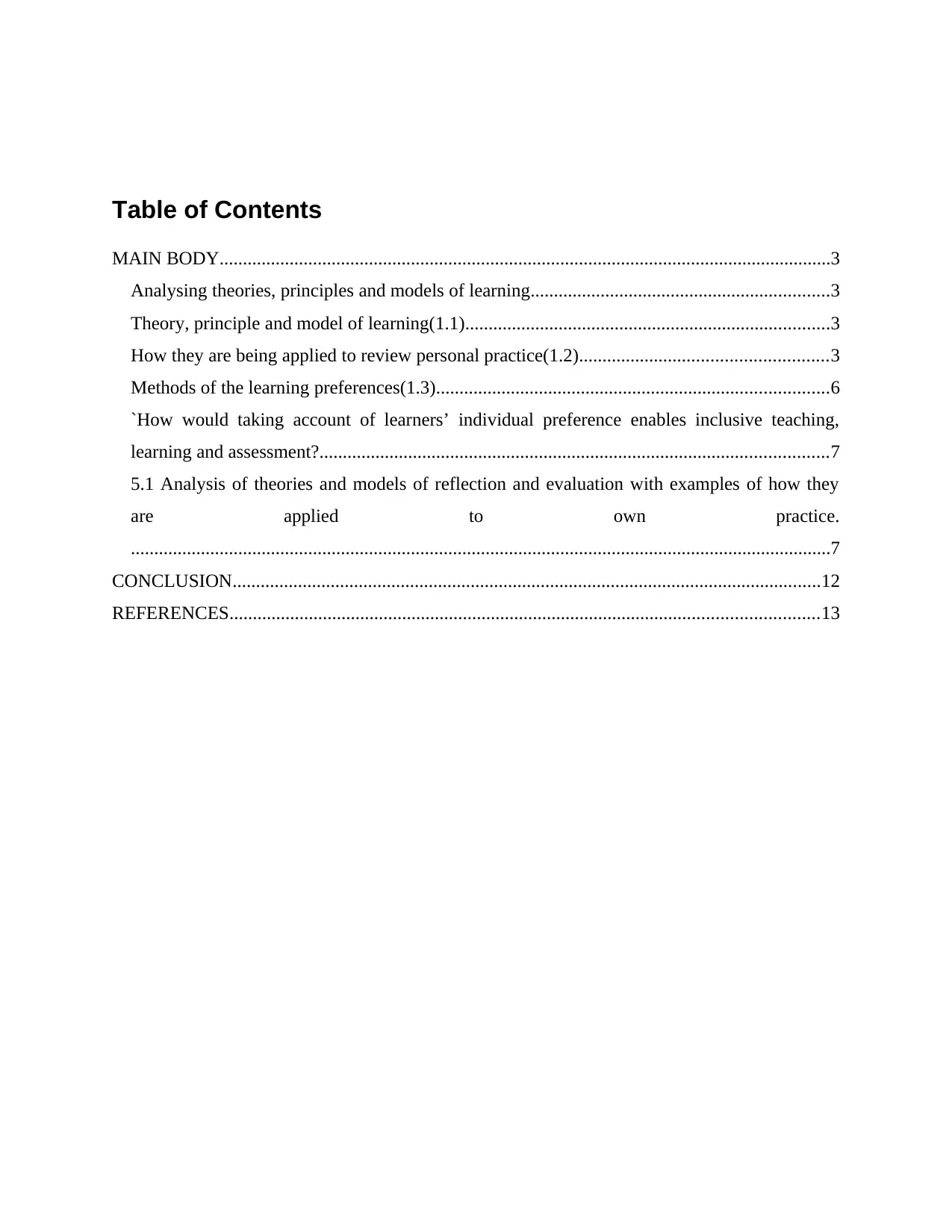
Table of Contents
MAIN BODY...................................................................................................................................3
Analysing theories, principles and models of learning................................................................3
Theory, principle and model of learning(1.1)..............................................................................3
How they are being applied to review personal practice(1.2).....................................................3
Methods of the learning preferences(1.3)....................................................................................6
`How would taking account of learners’ individual preference enables inclusive teaching,
learning and assessment?.............................................................................................................7
5.1 Analysis of theories and models of reflection and evaluation with examples of how they
are applied to own practice.
......................................................................................................................................................7
CONCLUSION..............................................................................................................................12
REFERENCES..............................................................................................................................13
MAIN BODY...................................................................................................................................3
Analysing theories, principles and models of learning................................................................3
Theory, principle and model of learning(1.1)..............................................................................3
How they are being applied to review personal practice(1.2).....................................................3
Methods of the learning preferences(1.3)....................................................................................6
`How would taking account of learners’ individual preference enables inclusive teaching,
learning and assessment?.............................................................................................................7
5.1 Analysis of theories and models of reflection and evaluation with examples of how they
are applied to own practice.
......................................................................................................................................................7
CONCLUSION..............................................................................................................................12
REFERENCES..............................................................................................................................13
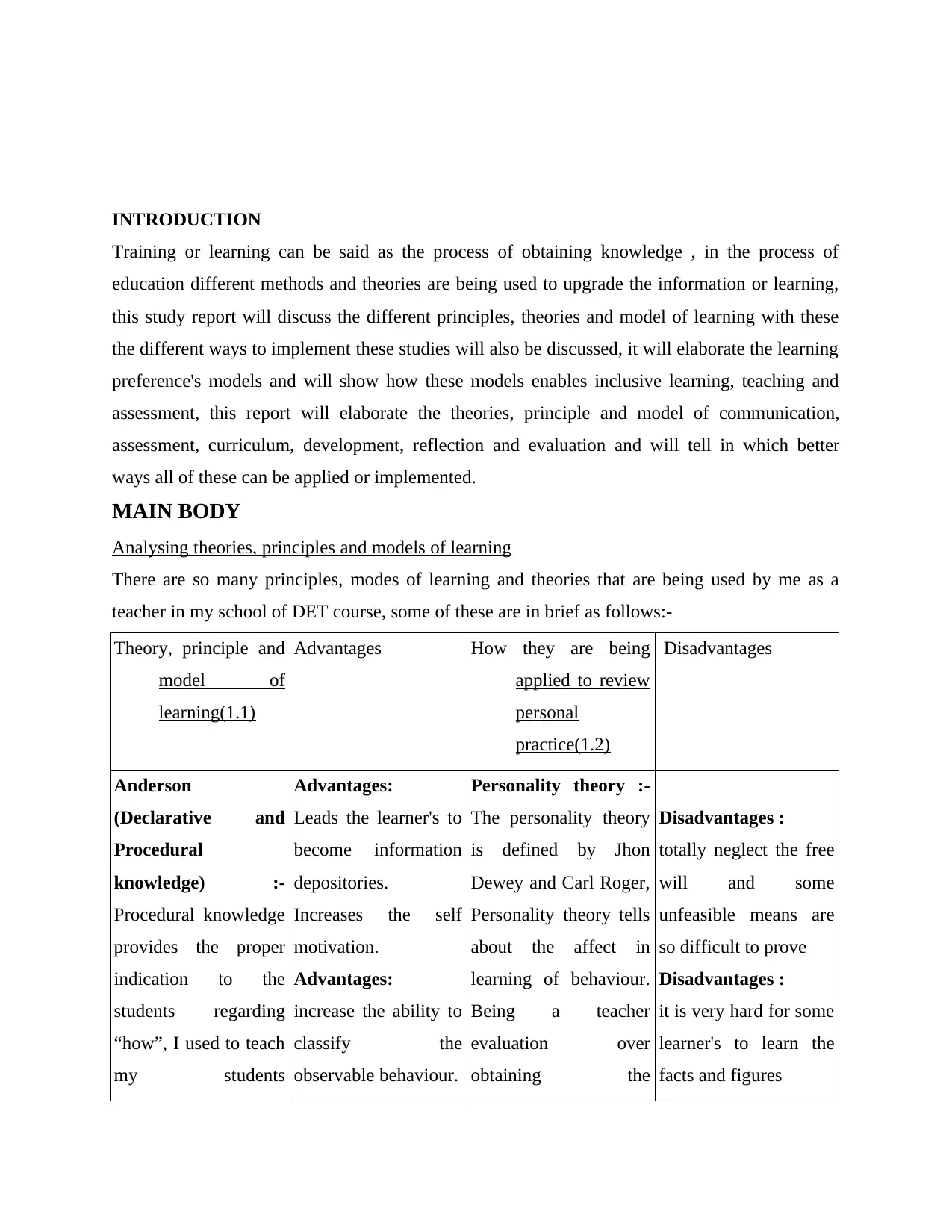
INTRODUCTION
Training or learning can be said as the process of obtaining knowledge , in the process of
education different methods and theories are being used to upgrade the information or learning,
this study report will discuss the different principles, theories and model of learning with these
the different ways to implement these studies will also be discussed, it will elaborate the learning
preference's models and will show how these models enables inclusive learning, teaching and
assessment, this report will elaborate the theories, principle and model of communication,
assessment, curriculum, development, reflection and evaluation and will tell in which better
ways all of these can be applied or implemented.
MAIN BODY
Analysing theories, principles and models of learning
There are so many principles, modes of learning and theories that are being used by me as a
teacher in my school of DET course, some of these are in brief as follows:-
Theory, principle and
model of
learning(1.1)
Advantages How they are being
applied to review
personal
practice(1.2)
Disadvantages
Anderson
(Declarative and
Procedural
knowledge) :-
Procedural knowledge
provides the proper
indication to the
students regarding
“how”, I used to teach
my students
Advantages:
Leads the learner's to
become information
depositories.
Increases the self
motivation.
Advantages:
increase the ability to
classify the
observable behaviour.
Personality theory :-
The personality theory
is defined by Jhon
Dewey and Carl Roger,
Personality theory tells
about the affect in
learning of behaviour.
Being a teacher
evaluation over
obtaining the
Disadvantages :
totally neglect the free
will and some
unfeasible means are
so difficult to prove
Disadvantages :
it is very hard for some
learner's to learn the
facts and figures
Training or learning can be said as the process of obtaining knowledge , in the process of
education different methods and theories are being used to upgrade the information or learning,
this study report will discuss the different principles, theories and model of learning with these
the different ways to implement these studies will also be discussed, it will elaborate the learning
preference's models and will show how these models enables inclusive learning, teaching and
assessment, this report will elaborate the theories, principle and model of communication,
assessment, curriculum, development, reflection and evaluation and will tell in which better
ways all of these can be applied or implemented.
MAIN BODY
Analysing theories, principles and models of learning
There are so many principles, modes of learning and theories that are being used by me as a
teacher in my school of DET course, some of these are in brief as follows:-
Theory, principle and
model of
learning(1.1)
Advantages How they are being
applied to review
personal
practice(1.2)
Disadvantages
Anderson
(Declarative and
Procedural
knowledge) :-
Procedural knowledge
provides the proper
indication to the
students regarding
“how”, I used to teach
my students
Advantages:
Leads the learner's to
become information
depositories.
Increases the self
motivation.
Advantages:
increase the ability to
classify the
observable behaviour.
Personality theory :-
The personality theory
is defined by Jhon
Dewey and Carl Roger,
Personality theory tells
about the affect in
learning of behaviour.
Being a teacher
evaluation over
obtaining the
Disadvantages :
totally neglect the free
will and some
unfeasible means are
so difficult to prove
Disadvantages :
it is very hard for some
learner's to learn the
facts and figures
⊘ This is a preview!⊘
Do you want full access?
Subscribe today to unlock all pages.

Trusted by 1+ million students worldwide
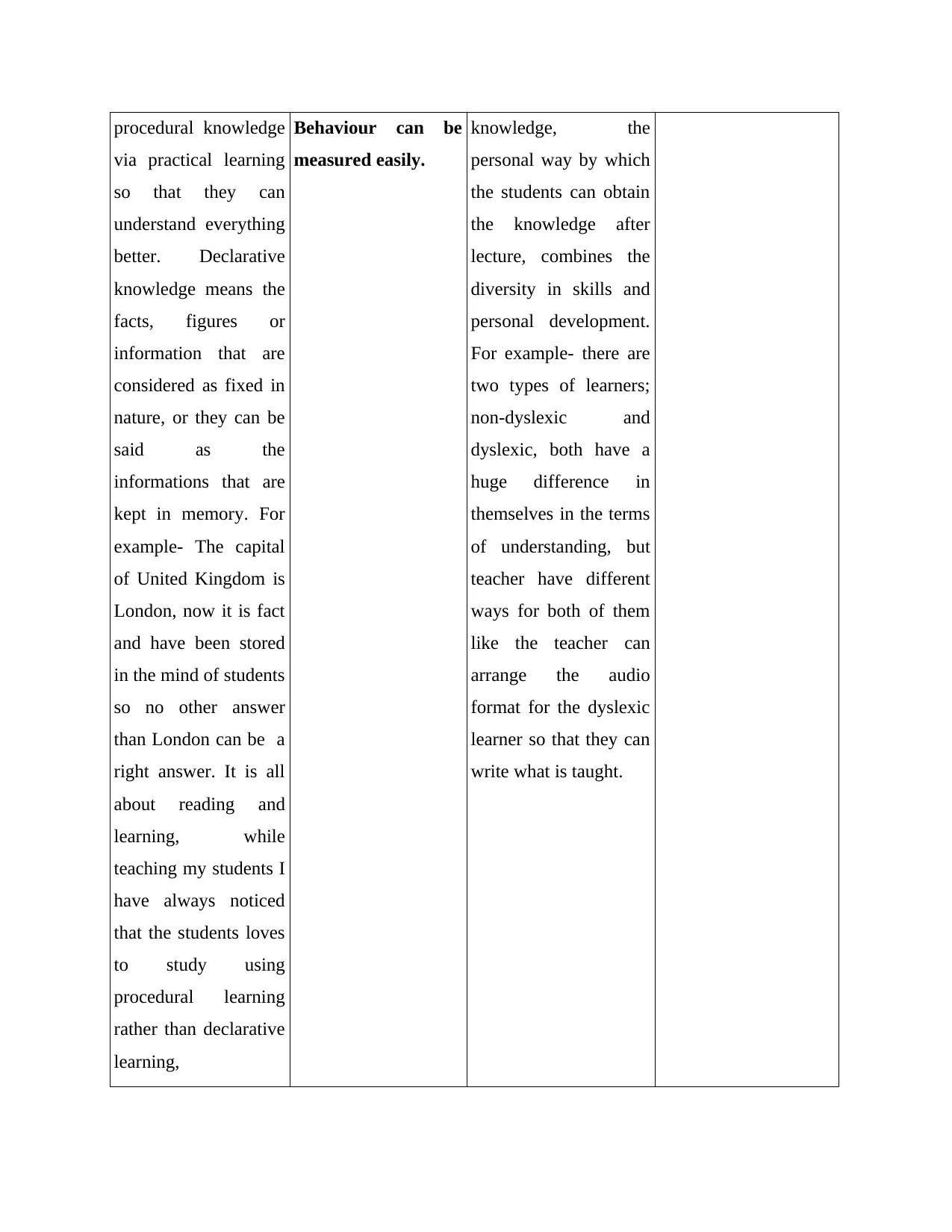
procedural knowledge
via practical learning
so that they can
understand everything
better. Declarative
knowledge means the
facts, figures or
information that are
considered as fixed in
nature, or they can be
said as the
informations that are
kept in memory. For
example- The capital
of United Kingdom is
London, now it is fact
and have been stored
in the mind of students
so no other answer
than London can be a
right answer. It is all
about reading and
learning, while
teaching my students I
have always noticed
that the students loves
to study using
procedural learning
rather than declarative
learning,
Behaviour can be
measured easily.
knowledge, the
personal way by which
the students can obtain
the knowledge after
lecture, combines the
diversity in skills and
personal development.
For example- there are
two types of learners;
non-dyslexic and
dyslexic, both have a
huge difference in
themselves in the terms
of understanding, but
teacher have different
ways for both of them
like the teacher can
arrange the audio
format for the dyslexic
learner so that they can
write what is taught.
via practical learning
so that they can
understand everything
better. Declarative
knowledge means the
facts, figures or
information that are
considered as fixed in
nature, or they can be
said as the
informations that are
kept in memory. For
example- The capital
of United Kingdom is
London, now it is fact
and have been stored
in the mind of students
so no other answer
than London can be a
right answer. It is all
about reading and
learning, while
teaching my students I
have always noticed
that the students loves
to study using
procedural learning
rather than declarative
learning,
Behaviour can be
measured easily.
knowledge, the
personal way by which
the students can obtain
the knowledge after
lecture, combines the
diversity in skills and
personal development.
For example- there are
two types of learners;
non-dyslexic and
dyslexic, both have a
huge difference in
themselves in the terms
of understanding, but
teacher have different
ways for both of them
like the teacher can
arrange the audio
format for the dyslexic
learner so that they can
write what is taught.
Paraphrase This Document
Need a fresh take? Get an instant paraphrase of this document with our AI Paraphraser
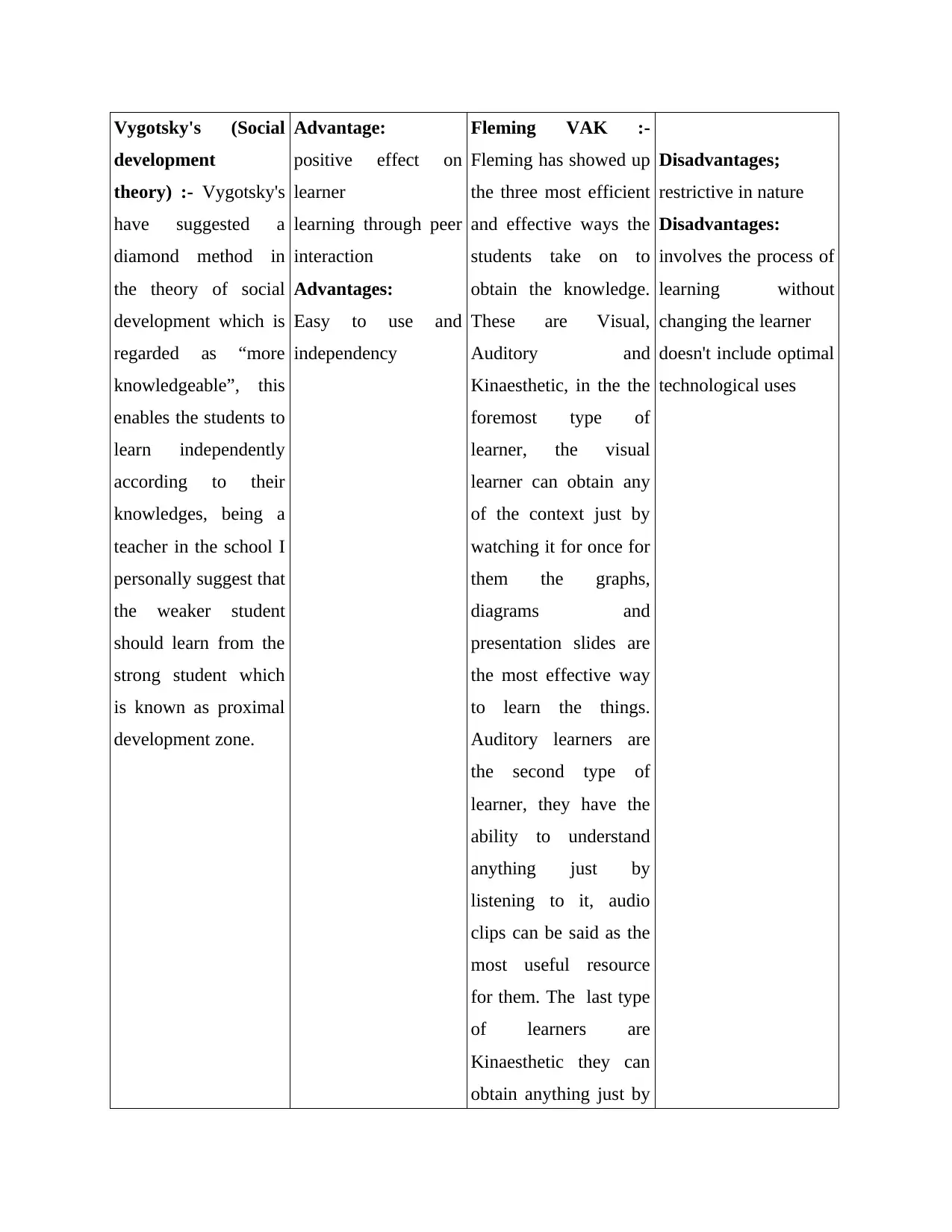
Vygotsky's (Social
development
theory) :- Vygotsky's
have suggested a
diamond method in
the theory of social
development which is
regarded as “more
knowledgeable”, this
enables the students to
learn independently
according to their
knowledges, being a
teacher in the school I
personally suggest that
the weaker student
should learn from the
strong student which
is known as proximal
development zone.
Advantage:
positive effect on
learner
learning through peer
interaction
Advantages:
Easy to use and
independency
Fleming VAK :-
Fleming has showed up
the three most efficient
and effective ways the
students take on to
obtain the knowledge.
These are Visual,
Auditory and
Kinaesthetic, in the the
foremost type of
learner, the visual
learner can obtain any
of the context just by
watching it for once for
them the graphs,
diagrams and
presentation slides are
the most effective way
to learn the things.
Auditory learners are
the second type of
learner, they have the
ability to understand
anything just by
listening to it, audio
clips can be said as the
most useful resource
for them. The last type
of learners are
Kinaesthetic they can
obtain anything just by
Disadvantages;
restrictive in nature
Disadvantages:
involves the process of
learning without
changing the learner
doesn't include optimal
technological uses
development
theory) :- Vygotsky's
have suggested a
diamond method in
the theory of social
development which is
regarded as “more
knowledgeable”, this
enables the students to
learn independently
according to their
knowledges, being a
teacher in the school I
personally suggest that
the weaker student
should learn from the
strong student which
is known as proximal
development zone.
Advantage:
positive effect on
learner
learning through peer
interaction
Advantages:
Easy to use and
independency
Fleming VAK :-
Fleming has showed up
the three most efficient
and effective ways the
students take on to
obtain the knowledge.
These are Visual,
Auditory and
Kinaesthetic, in the the
foremost type of
learner, the visual
learner can obtain any
of the context just by
watching it for once for
them the graphs,
diagrams and
presentation slides are
the most effective way
to learn the things.
Auditory learners are
the second type of
learner, they have the
ability to understand
anything just by
listening to it, audio
clips can be said as the
most useful resource
for them. The last type
of learners are
Kinaesthetic they can
obtain anything just by
Disadvantages;
restrictive in nature
Disadvantages:
involves the process of
learning without
changing the learner
doesn't include optimal
technological uses
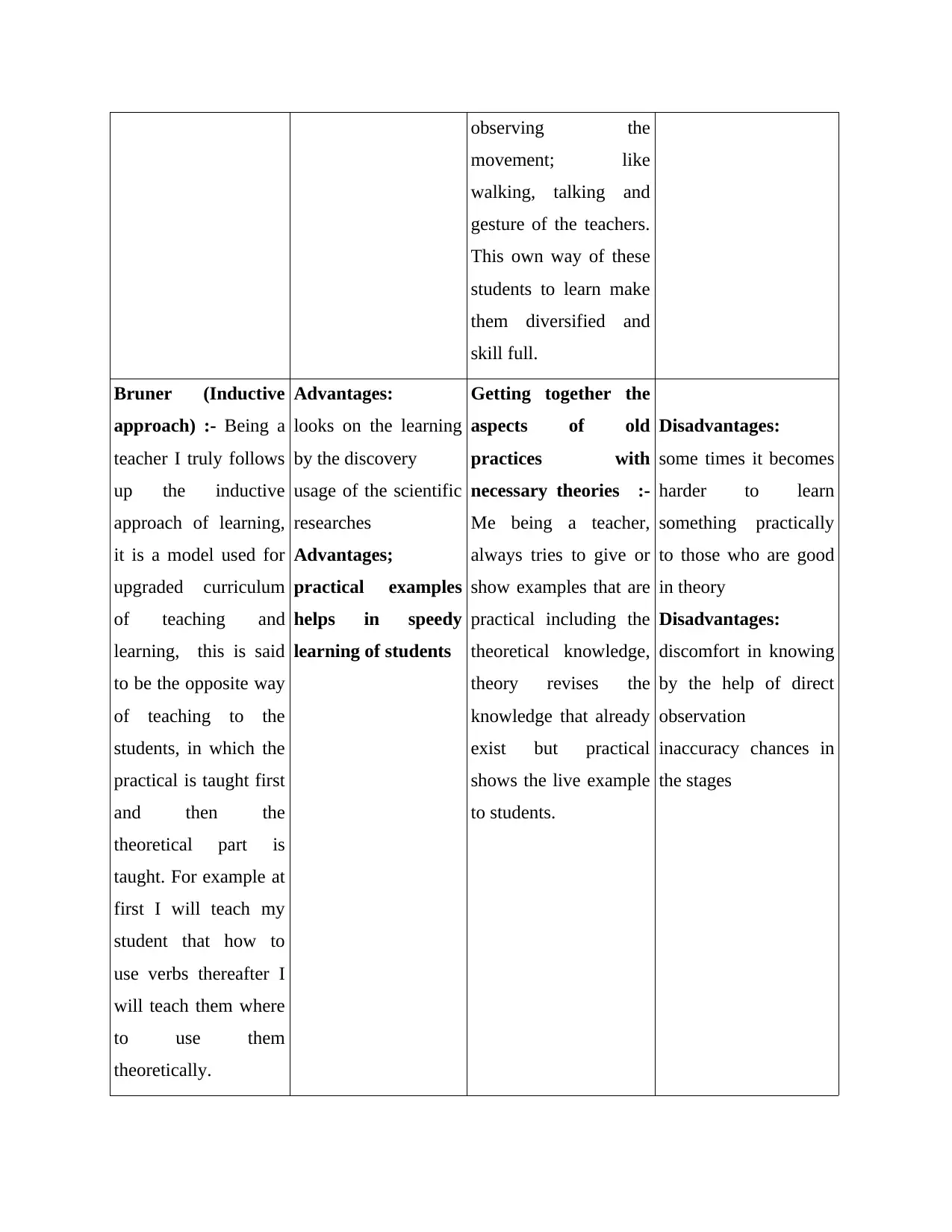
observing the
movement; like
walking, talking and
gesture of the teachers.
This own way of these
students to learn make
them diversified and
skill full.
Bruner (Inductive
approach) :- Being a
teacher I truly follows
up the inductive
approach of learning,
it is a model used for
upgraded curriculum
of teaching and
learning, this is said
to be the opposite way
of teaching to the
students, in which the
practical is taught first
and then the
theoretical part is
taught. For example at
first I will teach my
student that how to
use verbs thereafter I
will teach them where
to use them
theoretically.
Advantages:
looks on the learning
by the discovery
usage of the scientific
researches
Advantages;
practical examples
helps in speedy
learning of students
Getting together the
aspects of old
practices with
necessary theories :-
Me being a teacher,
always tries to give or
show examples that are
practical including the
theoretical knowledge,
theory revises the
knowledge that already
exist but practical
shows the live example
to students.
Disadvantages:
some times it becomes
harder to learn
something practically
to those who are good
in theory
Disadvantages:
discomfort in knowing
by the help of direct
observation
inaccuracy chances in
the stages
movement; like
walking, talking and
gesture of the teachers.
This own way of these
students to learn make
them diversified and
skill full.
Bruner (Inductive
approach) :- Being a
teacher I truly follows
up the inductive
approach of learning,
it is a model used for
upgraded curriculum
of teaching and
learning, this is said
to be the opposite way
of teaching to the
students, in which the
practical is taught first
and then the
theoretical part is
taught. For example at
first I will teach my
student that how to
use verbs thereafter I
will teach them where
to use them
theoretically.
Advantages:
looks on the learning
by the discovery
usage of the scientific
researches
Advantages;
practical examples
helps in speedy
learning of students
Getting together the
aspects of old
practices with
necessary theories :-
Me being a teacher,
always tries to give or
show examples that are
practical including the
theoretical knowledge,
theory revises the
knowledge that already
exist but practical
shows the live example
to students.
Disadvantages:
some times it becomes
harder to learn
something practically
to those who are good
in theory
Disadvantages:
discomfort in knowing
by the help of direct
observation
inaccuracy chances in
the stages
⊘ This is a preview!⊘
Do you want full access?
Subscribe today to unlock all pages.

Trusted by 1+ million students worldwide

Ausubel (deductive
approach) :- I also
follow the deductive
approach of learning
given by Ausubel
which is said to be the
contradictory learning
and teaching model
for the upgraded
curriculum, this
approach of learning
are used to make
learner attend practical
at first, in which being
a teacher I will
introduce the topic to
the students first and
then I will explain It
to them after that I
will let the learner's
personally experience
them practically, this
approach is “teacher
centred”, for example,
I will teach the right
forms of verbs in the
class to the students,
will solve their doubts
regarding the forms of
verbs then I will give
it to them as their
Advantages:
time saving and
straight to point
Advantages ;
helps in tackling the
barriers of learners
Developing the
teacher's personal
theories of learning :-
the teachers in the
school must have to
control the study
curriculum as
according to the
learner's competency,
beside this the primary
of me being a teacher is
tackling the barriers
that broke the
concentration of
students while learning
or studying.
Disadvantages:
curriculum is not
decided fairly
Disadvantages:
doesn't encourage the
divergent thinking
approach) :- I also
follow the deductive
approach of learning
given by Ausubel
which is said to be the
contradictory learning
and teaching model
for the upgraded
curriculum, this
approach of learning
are used to make
learner attend practical
at first, in which being
a teacher I will
introduce the topic to
the students first and
then I will explain It
to them after that I
will let the learner's
personally experience
them practically, this
approach is “teacher
centred”, for example,
I will teach the right
forms of verbs in the
class to the students,
will solve their doubts
regarding the forms of
verbs then I will give
it to them as their
Advantages:
time saving and
straight to point
Advantages ;
helps in tackling the
barriers of learners
Developing the
teacher's personal
theories of learning :-
the teachers in the
school must have to
control the study
curriculum as
according to the
learner's competency,
beside this the primary
of me being a teacher is
tackling the barriers
that broke the
concentration of
students while learning
or studying.
Disadvantages:
curriculum is not
decided fairly
Disadvantages:
doesn't encourage the
divergent thinking
Paraphrase This Document
Need a fresh take? Get an instant paraphrase of this document with our AI Paraphraser
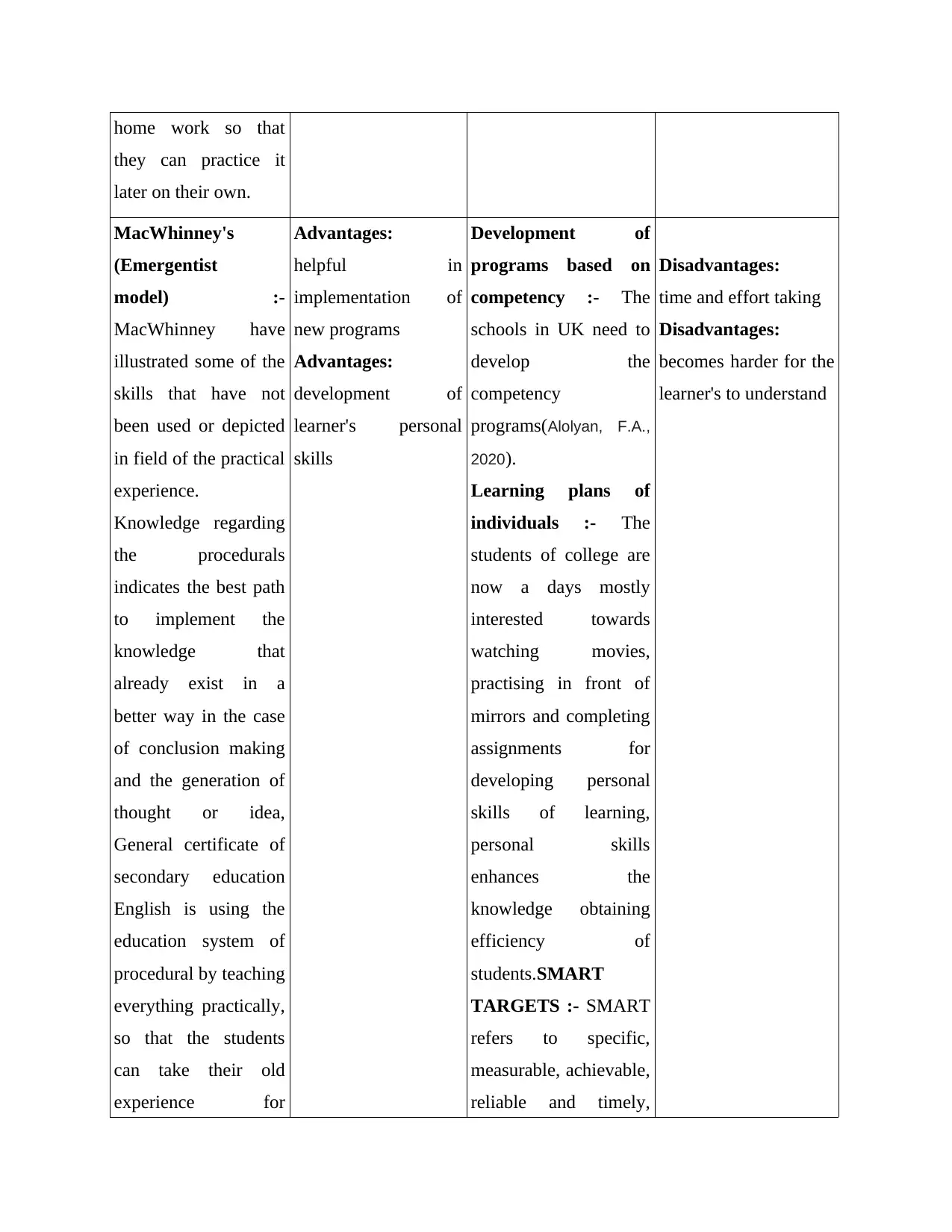
home work so that
they can practice it
later on their own.
MacWhinney's
(Emergentist
model) :-
MacWhinney have
illustrated some of the
skills that have not
been used or depicted
in field of the practical
experience.
Knowledge regarding
the procedurals
indicates the best path
to implement the
knowledge that
already exist in a
better way in the case
of conclusion making
and the generation of
thought or idea,
General certificate of
secondary education
English is using the
education system of
procedural by teaching
everything practically,
so that the students
can take their old
experience for
Advantages:
helpful in
implementation of
new programs
Advantages:
development of
learner's personal
skills
Development of
programs based on
competency :- The
schools in UK need to
develop the
competency
programs(Alolyan, F.A.,
2020).
Learning plans of
individuals :- The
students of college are
now a days mostly
interested towards
watching movies,
practising in front of
mirrors and completing
assignments for
developing personal
skills of learning,
personal skills
enhances the
knowledge obtaining
efficiency of
students.SMART
TARGETS :- SMART
refers to specific,
measurable, achievable,
reliable and timely,
Disadvantages:
time and effort taking
Disadvantages:
becomes harder for the
learner's to understand
they can practice it
later on their own.
MacWhinney's
(Emergentist
model) :-
MacWhinney have
illustrated some of the
skills that have not
been used or depicted
in field of the practical
experience.
Knowledge regarding
the procedurals
indicates the best path
to implement the
knowledge that
already exist in a
better way in the case
of conclusion making
and the generation of
thought or idea,
General certificate of
secondary education
English is using the
education system of
procedural by teaching
everything practically,
so that the students
can take their old
experience for
Advantages:
helpful in
implementation of
new programs
Advantages:
development of
learner's personal
skills
Development of
programs based on
competency :- The
schools in UK need to
develop the
competency
programs(Alolyan, F.A.,
2020).
Learning plans of
individuals :- The
students of college are
now a days mostly
interested towards
watching movies,
practising in front of
mirrors and completing
assignments for
developing personal
skills of learning,
personal skills
enhances the
knowledge obtaining
efficiency of
students.SMART
TARGETS :- SMART
refers to specific,
measurable, achievable,
reliable and timely,
Disadvantages:
time and effort taking
Disadvantages:
becomes harder for the
learner's to understand
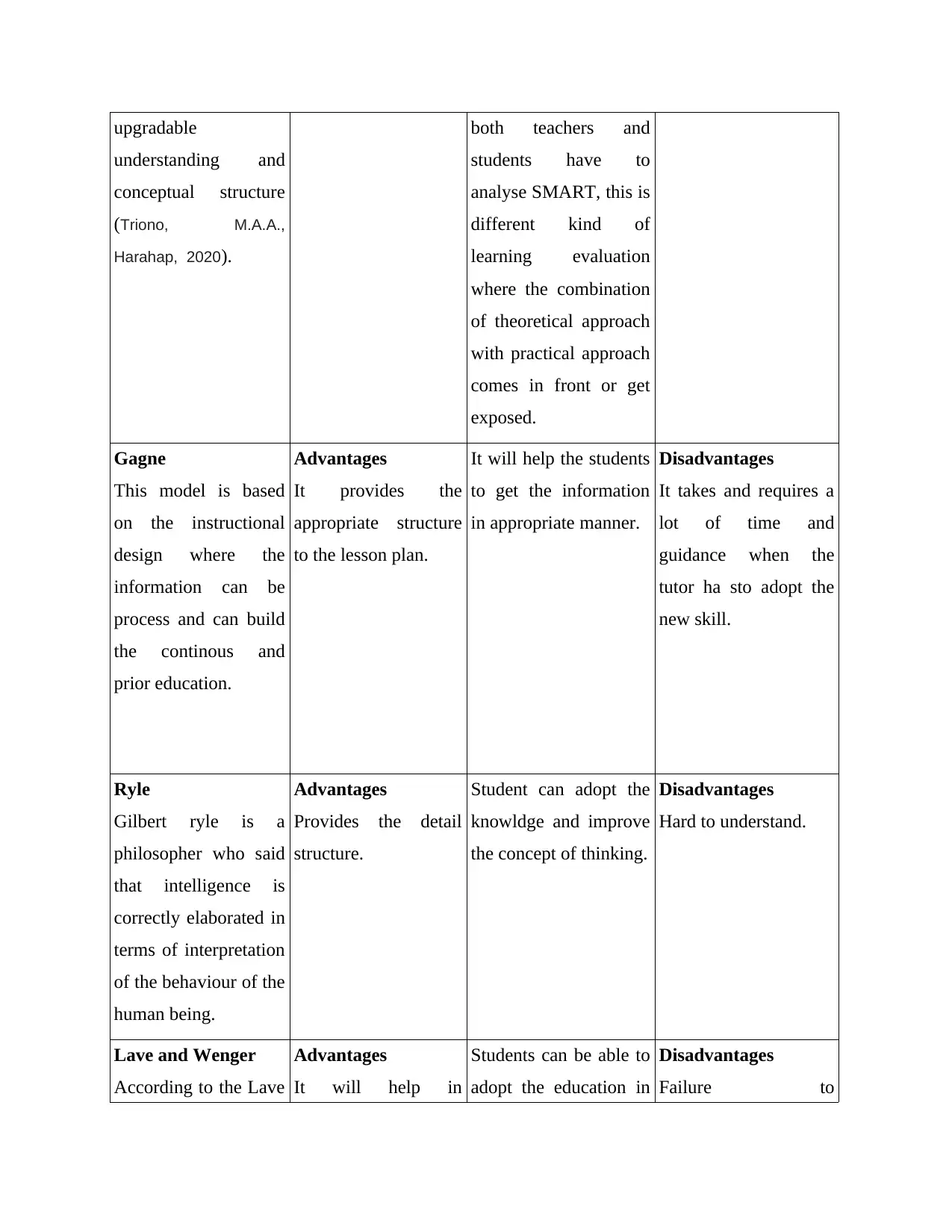
upgradable
understanding and
conceptual structure
(Triono, M.A.A.,
Harahap, 2020).
both teachers and
students have to
analyse SMART, this is
different kind of
learning evaluation
where the combination
of theoretical approach
with practical approach
comes in front or get
exposed.
Gagne
This model is based
on the instructional
design where the
information can be
process and can build
the continous and
prior education.
Advantages
It provides the
appropriate structure
to the lesson plan.
It will help the students
to get the information
in appropriate manner.
Disadvantages
It takes and requires a
lot of time and
guidance when the
tutor ha sto adopt the
new skill.
Ryle
Gilbert ryle is a
philosopher who said
that intelligence is
correctly elaborated in
terms of interpretation
of the behaviour of the
human being.
Advantages
Provides the detail
structure.
Student can adopt the
knowldge and improve
the concept of thinking.
Disadvantages
Hard to understand.
Lave and Wenger
According to the Lave
Advantages
It will help in
Students can be able to
adopt the education in
Disadvantages
Failure to
understanding and
conceptual structure
(Triono, M.A.A.,
Harahap, 2020).
both teachers and
students have to
analyse SMART, this is
different kind of
learning evaluation
where the combination
of theoretical approach
with practical approach
comes in front or get
exposed.
Gagne
This model is based
on the instructional
design where the
information can be
process and can build
the continous and
prior education.
Advantages
It provides the
appropriate structure
to the lesson plan.
It will help the students
to get the information
in appropriate manner.
Disadvantages
It takes and requires a
lot of time and
guidance when the
tutor ha sto adopt the
new skill.
Ryle
Gilbert ryle is a
philosopher who said
that intelligence is
correctly elaborated in
terms of interpretation
of the behaviour of the
human being.
Advantages
Provides the detail
structure.
Student can adopt the
knowldge and improve
the concept of thinking.
Disadvantages
Hard to understand.
Lave and Wenger
According to the Lave
Advantages
It will help in
Students can be able to
adopt the education in
Disadvantages
Failure to
⊘ This is a preview!⊘
Do you want full access?
Subscribe today to unlock all pages.

Trusted by 1+ million students worldwide

and Wanger, they
stated that learning is
a social process from
wher ethe education
and learning can be
co-constructed.
focusing on social
learning.
ongoing environment. acknowledge.
Freire
The Freire said that
knowledge and
education is the act
where the men and
women makes sense
rto learn which can be
remake as they both
are responsible for
themselves.
Advantages
It is a teaching
method where it help
in challenging against
the social customs
and beliefs.
It will help to adopt the
knowledge
appropriately.
Disadvantages
It is difficult for
learner to adopt and
understand.
Dewey/Rogers
As, per the Dewey the
student and learner
must have to invest
everything in what
they are learning.
Advantages
Learning by doing
experiment and
practical
Students can be able to
understand the conept
and learning in
effective manner.
Disadvantages
Not provide deeper
learning.
Methods of the learning preferences(1.3)
Methods of the learning preferences that are used in school are as follows :-
Honey and Mumford model — In this model the four learning styles are discussed, these are
activist, pragmatist, reflector and theorist. All of these in brief are as follows:-
stated that learning is
a social process from
wher ethe education
and learning can be
co-constructed.
focusing on social
learning.
ongoing environment. acknowledge.
Freire
The Freire said that
knowledge and
education is the act
where the men and
women makes sense
rto learn which can be
remake as they both
are responsible for
themselves.
Advantages
It is a teaching
method where it help
in challenging against
the social customs
and beliefs.
It will help to adopt the
knowledge
appropriately.
Disadvantages
It is difficult for
learner to adopt and
understand.
Dewey/Rogers
As, per the Dewey the
student and learner
must have to invest
everything in what
they are learning.
Advantages
Learning by doing
experiment and
practical
Students can be able to
understand the conept
and learning in
effective manner.
Disadvantages
Not provide deeper
learning.
Methods of the learning preferences(1.3)
Methods of the learning preferences that are used in school are as follows :-
Honey and Mumford model — In this model the four learning styles are discussed, these are
activist, pragmatist, reflector and theorist. All of these in brief are as follows:-
Paraphrase This Document
Need a fresh take? Get an instant paraphrase of this document with our AI Paraphraser
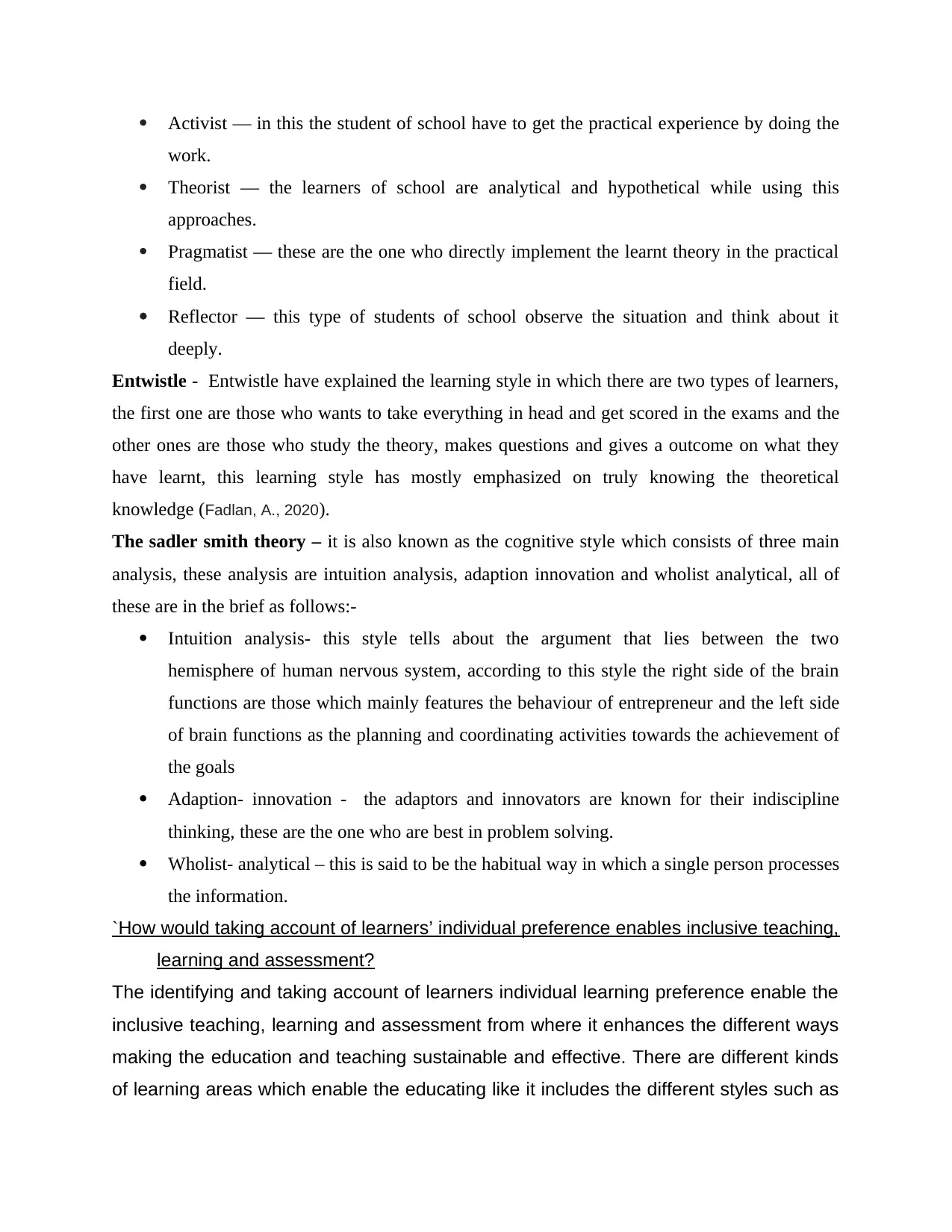
Activist — in this the student of school have to get the practical experience by doing the
work.
Theorist — the learners of school are analytical and hypothetical while using this
approaches.
Pragmatist — these are the one who directly implement the learnt theory in the practical
field.
Reflector — this type of students of school observe the situation and think about it
deeply.
Entwistle - Entwistle have explained the learning style in which there are two types of learners,
the first one are those who wants to take everything in head and get scored in the exams and the
other ones are those who study the theory, makes questions and gives a outcome on what they
have learnt, this learning style has mostly emphasized on truly knowing the theoretical
knowledge (Fadlan, A., 2020).
The sadler smith theory – it is also known as the cognitive style which consists of three main
analysis, these analysis are intuition analysis, adaption innovation and wholist analytical, all of
these are in the brief as follows:-
Intuition analysis- this style tells about the argument that lies between the two
hemisphere of human nervous system, according to this style the right side of the brain
functions are those which mainly features the behaviour of entrepreneur and the left side
of brain functions as the planning and coordinating activities towards the achievement of
the goals
Adaption- innovation - the adaptors and innovators are known for their indiscipline
thinking, these are the one who are best in problem solving.
Wholist- analytical – this is said to be the habitual way in which a single person processes
the information.
`How would taking account of learners’ individual preference enables inclusive teaching,
learning and assessment?
The identifying and taking account of learners individual learning preference enable the
inclusive teaching, learning and assessment from where it enhances the different ways
making the education and teaching sustainable and effective. There are different kinds
of learning areas which enable the educating like it includes the different styles such as
work.
Theorist — the learners of school are analytical and hypothetical while using this
approaches.
Pragmatist — these are the one who directly implement the learnt theory in the practical
field.
Reflector — this type of students of school observe the situation and think about it
deeply.
Entwistle - Entwistle have explained the learning style in which there are two types of learners,
the first one are those who wants to take everything in head and get scored in the exams and the
other ones are those who study the theory, makes questions and gives a outcome on what they
have learnt, this learning style has mostly emphasized on truly knowing the theoretical
knowledge (Fadlan, A., 2020).
The sadler smith theory – it is also known as the cognitive style which consists of three main
analysis, these analysis are intuition analysis, adaption innovation and wholist analytical, all of
these are in the brief as follows:-
Intuition analysis- this style tells about the argument that lies between the two
hemisphere of human nervous system, according to this style the right side of the brain
functions are those which mainly features the behaviour of entrepreneur and the left side
of brain functions as the planning and coordinating activities towards the achievement of
the goals
Adaption- innovation - the adaptors and innovators are known for their indiscipline
thinking, these are the one who are best in problem solving.
Wholist- analytical – this is said to be the habitual way in which a single person processes
the information.
`How would taking account of learners’ individual preference enables inclusive teaching,
learning and assessment?
The identifying and taking account of learners individual learning preference enable the
inclusive teaching, learning and assessment from where it enhances the different ways
making the education and teaching sustainable and effective. There are different kinds
of learning areas which enable the educating like it includes the different styles such as
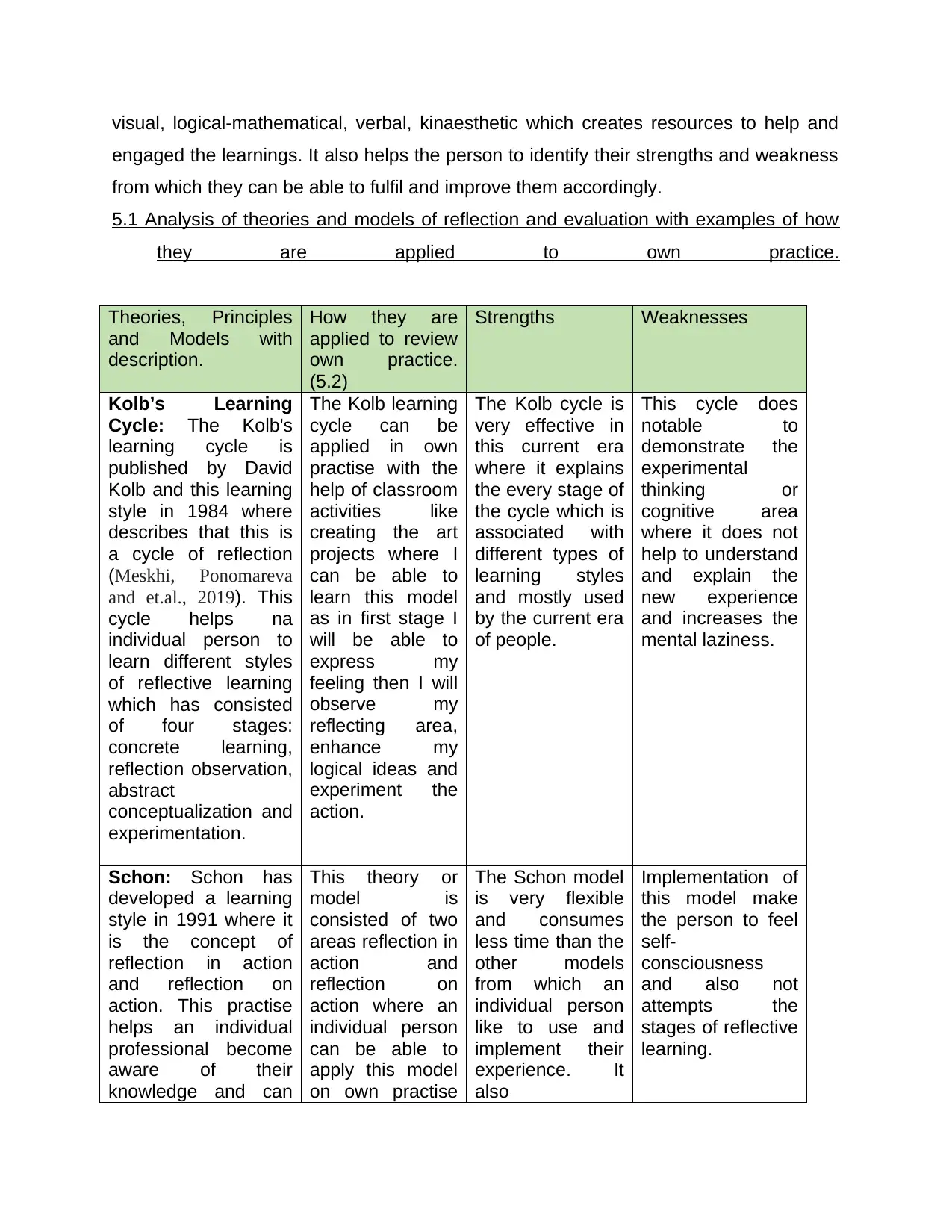
visual, logical-mathematical, verbal, kinaesthetic which creates resources to help and
engaged the learnings. It also helps the person to identify their strengths and weakness
from which they can be able to fulfil and improve them accordingly.
5.1 Analysis of theories and models of reflection and evaluation with examples of how
they are applied to own practice.
Theories, Principles
and Models with
description.
How they are
applied to review
own practice.
(5.2)
Strengths Weaknesses
Kolb’s Learning
Cycle: The Kolb's
learning cycle is
published by David
Kolb and this learning
style in 1984 where
describes that this is
a cycle of reflection
(Meskhi, Ponomareva
and et.al., 2019). This
cycle helps na
individual person to
learn different styles
of reflective learning
which has consisted
of four stages:
concrete learning,
reflection observation,
abstract
conceptualization and
experimentation.
The Kolb learning
cycle can be
applied in own
practise with the
help of classroom
activities like
creating the art
projects where I
can be able to
learn this model
as in first stage I
will be able to
express my
feeling then I will
observe my
reflecting area,
enhance my
logical ideas and
experiment the
action.
The Kolb cycle is
very effective in
this current era
where it explains
the every stage of
the cycle which is
associated with
different types of
learning styles
and mostly used
by the current era
of people.
This cycle does
notable to
demonstrate the
experimental
thinking or
cognitive area
where it does not
help to understand
and explain the
new experience
and increases the
mental laziness.
Schon: Schon has
developed a learning
style in 1991 where it
is the concept of
reflection in action
and reflection on
action. This practise
helps an individual
professional become
aware of their
knowledge and can
This theory or
model is
consisted of two
areas reflection in
action and
reflection on
action where an
individual person
can be able to
apply this model
on own practise
The Schon model
is very flexible
and consumes
less time than the
other models
from which an
individual person
like to use and
implement their
experience. It
also
Implementation of
this model make
the person to feel
self-
consciousness
and also not
attempts the
stages of reflective
learning.
engaged the learnings. It also helps the person to identify their strengths and weakness
from which they can be able to fulfil and improve them accordingly.
5.1 Analysis of theories and models of reflection and evaluation with examples of how
they are applied to own practice.
Theories, Principles
and Models with
description.
How they are
applied to review
own practice.
(5.2)
Strengths Weaknesses
Kolb’s Learning
Cycle: The Kolb's
learning cycle is
published by David
Kolb and this learning
style in 1984 where
describes that this is
a cycle of reflection
(Meskhi, Ponomareva
and et.al., 2019). This
cycle helps na
individual person to
learn different styles
of reflective learning
which has consisted
of four stages:
concrete learning,
reflection observation,
abstract
conceptualization and
experimentation.
The Kolb learning
cycle can be
applied in own
practise with the
help of classroom
activities like
creating the art
projects where I
can be able to
learn this model
as in first stage I
will be able to
express my
feeling then I will
observe my
reflecting area,
enhance my
logical ideas and
experiment the
action.
The Kolb cycle is
very effective in
this current era
where it explains
the every stage of
the cycle which is
associated with
different types of
learning styles
and mostly used
by the current era
of people.
This cycle does
notable to
demonstrate the
experimental
thinking or
cognitive area
where it does not
help to understand
and explain the
new experience
and increases the
mental laziness.
Schon: Schon has
developed a learning
style in 1991 where it
is the concept of
reflection in action
and reflection on
action. This practise
helps an individual
professional become
aware of their
knowledge and can
This theory or
model is
consisted of two
areas reflection in
action and
reflection on
action where an
individual person
can be able to
apply this model
on own practise
The Schon model
is very flexible
and consumes
less time than the
other models
from which an
individual person
like to use and
implement their
experience. It
also
Implementation of
this model make
the person to feel
self-
consciousness
and also not
attempts the
stages of reflective
learning.
⊘ This is a preview!⊘
Do you want full access?
Subscribe today to unlock all pages.

Trusted by 1+ million students worldwide
1 out of 18
Related Documents
Your All-in-One AI-Powered Toolkit for Academic Success.
+13062052269
info@desklib.com
Available 24*7 on WhatsApp / Email
![[object Object]](/_next/static/media/star-bottom.7253800d.svg)
Unlock your academic potential
Copyright © 2020–2025 A2Z Services. All Rights Reserved. Developed and managed by ZUCOL.



